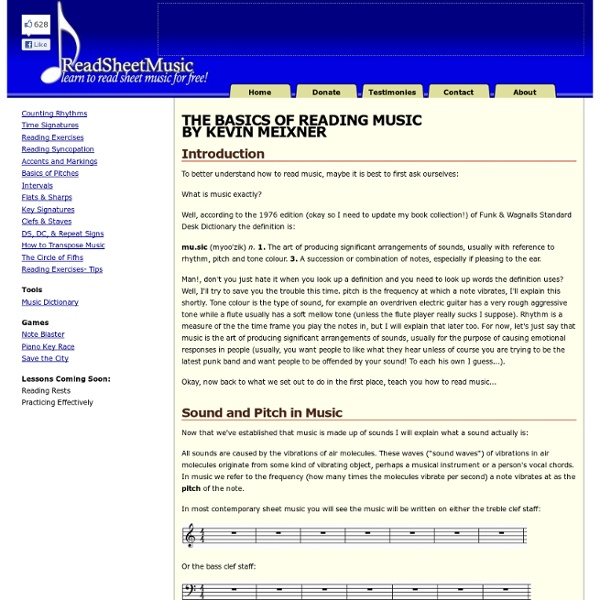The Basics of Reading Music - By Kevin Meixner

Learning to Read Music - How to read music notation
Learning to Read Music - How to read music notation This section contains information on how to read and interpret music notation, which may be useful to beginners. This is information which may help if you are learning the piano or keyboard or indeed any other musical instrument. It is mainly most useful for musical reference purposes. The content of this musical reference section includes : The Musical Staff In musical notation, the musical staff or stave is a set of five horizontal lines on which musical note symbols are placed to indicate pitch and time. The musical staff on its own does not help you to represent any specific notes, that is without a musical clef. The two main types of musical clefs are shown below and the notes for each clef are shown on it - Middle C has been underlined with a red mark. Musical Scales In musical terms, a scale is an ascending or descending series of notes or pitches. Playing Musical Scales on Piano Playing Scale of C (Treble Clef) with the right hand
San Diego Pianist Lee Galloway Classical to Jazz Piano
Free Guitar Lesson - TB-000 • The Basics and General Concepts - Namoroka
This area is to explain all the basic stuff about playing guitar. Some of it is pretty easy stuff aimed at beginners but there is some more advanced ideas and concepts too. How To... Essential skills for all guitarists. TB-001 • How To Tune Your Guitar Use mp3 files as reference notes to tune your guitar. TB-002 • How To Tune Your Guitar (Advanced) Uses harmonics and fancy tricks to tune your guitar. TB-003 • How To Change Strings On An Electric Guitar Changing strings is not as hard as you might think. TB-004 • How To Change Strings On An Acoustic Guitar Changing strings is not as hard as you might think. TB-005 • How To Remember String Names Everyone needs to know the note names of open strings. TB-006 • How to Use The Note Circle This shows you how to work out your tones and semitones, and what they are. TB-007 • How To Find The Notes On The Neck A diagram and exercise to learn the note positions on the guitar neck. TB-008 • How To Use Octaves Use octaves to find the notes on the neck.
Guitar Lessons - Basic Strumming Patterns Video – 5min.com - Namoroka
Alright again, we are going to learn about strumming today and this video is specifically supporting the guitar lessons that you can purchase from your guitarstage.com, and if you can get it without getting the E book that I have on there, that the E book talks about strumming, on how to read charts, how to play your chords correctly whole nine yards. But if you get it without great, if not, check out the E book there at your guitarstage.com and without further a do, let us keep going. So, what we are going to talk about today is strumming and how we should think about strumming when we are playing. One would think that it is just as easy as just up and down. Well, we need to think about the beat, the beat, your down beat is when your foot hits the ground, so, we had a strum, this little 1, 2, 3, 4, 1, 2, 3, 4, that is when I put it on the ground, this are down beats. Now, for some of you who maybe able to just do that right away, that is great.
Free Online Piano Lessons - Learn How to Play Piano - Namoroka
Learn Piano by Chords How To Play Piano - Namoroka
Related:
Related:



